|
The Joffrey Ballet and The Green Table
One of the dance companies I missed most in the past decade or so in the San Francisco Bay Area was the Joffrey Ballet with its extraordinary reconstructions of landmark historical ballets, a mission that only the Oakland Ballet shared in its heyday. Thanks to Cal Performances' new directorship the Joffrey returned to Zellerbach Hall this month and the old connection was restored. Together with contemporary dance experiments, the company brought back its celebrated restoration of Der Grüne Tisch, The Green Table, one of the great story-telling creations of early modern dance.
 |
The radical anti-war ballet was created in Germany (and premiered in Paris) in 1932, while the violent take-over by the Nazis was already in full swing. The Green Table by Kurt Jooss makes satirical fun of politicians and their diplomacy: 10 funny little men on opposite sides of a green felt-covered table dispute, grand-stand, grab their beards, shake white-gloved fingers, bow in fake politesse, perform slimy little menuets of compromise for each other, all to the melody of an innocuous thirties tango – only to point 10 revolvers at each other and fire off the starting shots of war.
Then, in fairy-tale simplicity, the God of War, part warrior-monster, part skeletal Reaper, begins his unstoppable march, his marche funèbre. In 8 tableaus, we see the human toll – from the naïve enthusiasm of young soldiers and their girls to defeat, betrayal, degradation, death. Nobody is spared. A final danse macabre leads the victims once more across the stage (a scene recalling Ingmar Bergman's Seventh Seal), and there they are again -- the same politicians pirouetting with their white gloves and hidden guns, tangoing around the green table…
80 years ago this work of pacifist, dangerously "degenerate" art ought to have got Jooss and his company arrested. Instead, Jooss cleverly escaped Nazi prosecution by taking the ballet on tour – a long world tour, as it turned out. The Green Table was shown thousands of times, enough to become famous all over the globe. After the war, Jooss was welcomed back to post-war Germany. He rebuilt his company, the Folkwang Ballett, in the town Essen, and created his own ballet school. Classical and modern dance (in the Mary Wigman tradition) were taught, producing the dancer and choreographer Pina Bausch, the German genius who dominated dance theater from the seventies onward. For anyone who is an admirer of Bausch, The Green Table is a must-see: like in a time capsule you can trace the stylistic elements that evolved into Bausch's brilliant creations.
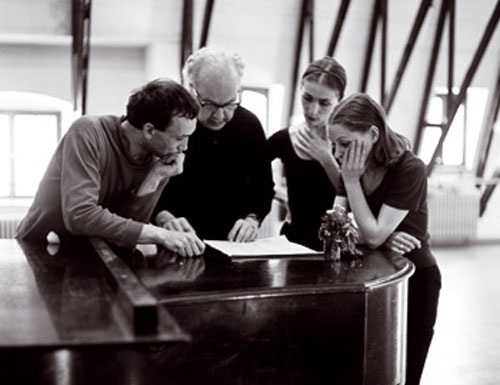 |
The style of Jooss' Green Table is often called expressionist, a term that today invokes the German silent movie era with its grotesque overstatements -- think of The Cabinet of Dr. Caligari. You won't find this in the version that the Joffrey Ballet first reconstructed in 1967 and now staged anew. The war allegory, subtitled "A Dance of Death in Eight Scenes," is told in an arcane, earthy language with medieval connotations (the modern dance vocabulary of Mark Morris and Mats Ek comes to mind). The scenes are short and to the point, with nothing extra, with intense lines of energy shifting from groups to individuals, movement to stillness, all in the service of the shortest line to an emotional impact. This stylistic minimalism, punctuated by a stark, simple double piano score by F.A. Cohen and costumes by Hein Heckroth (of The Red Shoes Hollywood fame), makes the piece refreshingly alien and "new."
There are only few, but effective melodramatic gestures: When the figure of the Old Mother (an impressive Joanna Wozniak) argues with Death, raising angular arms and swaying her body, she is both intense and subtle. There is humility and acceptance in her plea, and Death takes her in his muscular arms and carries her away like a brittle child. Equally moving is the Brothel scene with the Young Girl (Christine Rocas) whose innocence is lost and yet partly saved when Death steps in and takes over her dance with the soldier who bought her.
Back in the sixties, when Pina Bausch was still dancing, I saw her in the part of the Young Girl and was shaken by the intensity of the story she seemed to be telling in her dance. Nothing this earth-shattering was happening in the contemporary casting by the Joffrey, but there was enough conviction in the whole cast to bring out the power of the piece, making me think of the famous line by the Jewish poet Paul Celan, "Death is a master from Germany."
San Francisco Ballet with Serge Lifar's Suite en Blanc
"Sometimes it's not bad to take a look back," mused San Francisco Ballet's artistic director Helgi Tomasson with classical understatement– and did just that. Within a couple of days, the SF Bay Area had the rare pleasure of beholding another historic gem, this one from the watershed moments in European dance that started off neo-classicism. Serge Lifar was discovered by Nijinsky's sister, Bronislava Nijinska, for Diaghilev's Ballets Russes, where he evolved as a principal dancer, creating one of Balanchine's most enduringly famous ballets, Apollon Musagète. After Diaghilev's death in 1929, Lifar set out on his own and began choreographing. He founded the Nouveau Ballet of Monte Carlo and choreographed for the Paris Opera Ballet whose artistic director he became for many years. In 1981, five years before his death, Lifar restaged Suite en Blanc for the Australian Ballet, and one of Suite en Blanc's prominent dancers of the past, Maina Gielgud, revived the neoclassic piece for San Francisco Ballet. In the States, this is only its third presentation – a mystery when you consider the certain Balanchine fatigue of the 21st century.
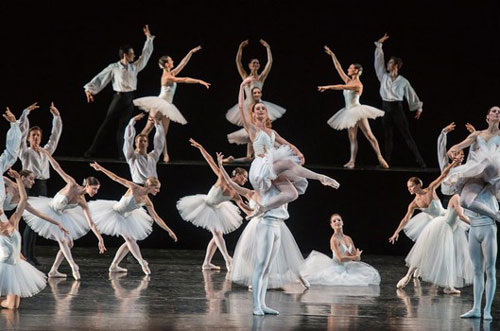 |
Suite en Blanc is a true discovery, a gem of unusual playfulness. It offers beautiful, entertaining classical dance with just enough modernist spice – unexpected asymmetries, sexy body turns, charming head and arm inclinations, and — right out of the Ballets Russes repertoire — torsos pointing forward with legs strutting sideways. And what a strut! As in a casino setting, all draped in velvety black, the brilliantly white-dressed dancers appear and disappear on two tiers, descending invisible stairs or sitting lined up like bright little stars, limbs nicely folded over those stairs, while others gambol in little groups, solos and the occasional pas de deux to joyful music by French composer Edouard Lalo.
The divertissement is danced by the company in just the right style of formal precision and relaxedness. You can literally feel the relief that for once, Mr. B has nothing to say about it. (I am sure he would call it simply charming.) The spirit of freshness and pure fun lift the ballet straight out of the historical dust closet into contemporary relevance. Following Maina Gielgud's advice to "indulge in the style" and "flirt with it," this was particularly charmingly done by Sofiane Sylve in her sensuous, pliable solo, accompanied by the cat-like purr of her smile. Sarah van Patten showed impeccable technical beauty in her solo as well as a pas de deux with Tiits Helimet, but her severe, hypnotic stare didn't exactly exude charm; for some reason she seemed to feel the need to add some Black Swan into all this joyfully glittering white.
San Francisco Ballet with the reprisal of
Jerome Robbins' In the Night
In another clever move of programming, Tomasson allowed a leap forward in the past, from 1943 to 1970, giving his audience another look at one of the "hits" of San Francisco Ballet's repertoire: Jerome Robbins' exquisite, romantic piece for three couples, In the Night. Set to several Nocturnes by Chopin, staged in front of a black backdrop sprinkled with stars, each couple represents a different stage of a love relationship – from first love to the ambiguities of maturity, to the tear and wear of passion and discord. It's a choreography inspired by Balanchine that takes the classical pas de deux to a peak of sophisticated simplicity, emotionality and beauty. I saw the piece a few years ago in a partly different cast and was surprised how different the emotional narrative appeared this time. Dores André with Jaime Garcia Castilla would have needed more exuberance, wonder and naïveté to set the young lovers apart from the second couple. Marie-Claire d'Lyse with Shane Wuerthner performed a beautiful, suave pas de deux with hardly a story to tell. Where was the secret, underlying tension of sacrifices to a committed relationship? Where were the restrictions, formalities, subtle limitations and doubts that are as much part of the choreography as the tender certitudes and controlled feelings? Newly joined, gifted Corps member Marie-Claire d'Lyse has all the technical skills needed, but there is room for psychological growth and artistic depth that would take her beyond the stereotypical ballerina smile and grace. This left the true story telling once again to Lorena Feijoo and Pierre-François Vilanoba, the ideal partnership from the last presentation I saw. Once again, the stage exploded with the expressive richness, emotional power and technical brilliance of Feijoo whose dancing does so much more than just dance. After a year of absence for injuries and then her first maternity leave, Feijoo is finally back. The temperature on stage shot up to a moment of heat and passion that is rare in classical ballet and was duly acknowledged by the enthusiastic audience.
Body-torture modernism
As chance had it, the historical examples of modernism and neo-classic modernisation -- from Jooss to Lifar to Robbins – were placed in a context ofultra-modern choreographies by all three companies. The contrast could not have been more fascinating and disturbing. I will focus here on the brand-new works, Hubbard Street's first-ever collaboration with Alonzo King's Lines Company in the world premiere of Azimuth, and San Francisco Ballet's world premiere of Borderlands by Wayne McGregor. Although King's work is always more "balletic," the new piece comfortably fits in the post-modern box I call "body torture ballet". Whether with point shoes or without, twisting, knotting, pushing and pulling the body into grotesque shapes and extensions, tearing the classic pas de deux into squirming, rape-like combats is the name of the game – a game old enough by now (two decades and counting) that it is mastered by all three companies to near perfection. The question more and more urgently is: so what?
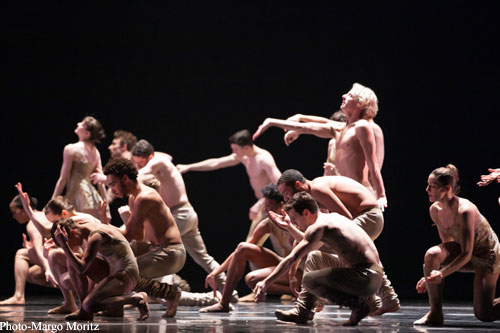 |
Azimuth by Alonzo King
Alonzo King's work has most often left me with a feeling of the Emperor's New Clothes. His San Francisco based Lines Company stands out with chic costumes,potent dancers with often extreme body-shapes, artistic lighting, original, often live music and altogether highly photogenic production values. King has all the collaborators to make Lines fashionable, but his choreography rarely has more to say than some version of, "let's see how we could twist the body into some counter-intuitive and newly bizarre positions: they make no sense at all but look how hugely original they are. "This narcissistic preoccupation with "originality" — the Lines trademark -- surely makes for a strange and occasionally dazzling style, but what is sorely missing is a meaningful choreographic vision of movement, a concept of a piece of dance as an organic,coherent whole.
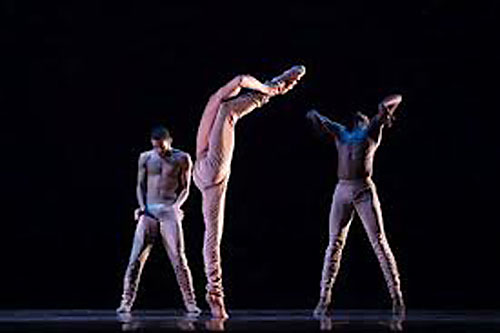 |
This lack of vision is made up for by King's inclination to write up statements about his dance "philosophy" that could fool you if you didn't pay attention. For his premiere of Azimuth – a collaboration mixing the Lines dancers with the Hubbard Street group – he found this to say: "Artistically, azimuth is the distance between where you are (axis mundi) and where you are headed (aspiration, goal), erased by absorption. The measurement between focus and object, or observer and subject, annihilated through union." Could you please say that again?
Still, the collaboration– 28 dancers from both companies — seemed to help King move a step out of his navel-gazing. The beautiful male dancers ate up the space without, for some strange reason, being given enough solo time to really show off their individual power. (Was the "original" idea here to leave both the dancers and the audience hungry?) The stunning women, alas, received hardly any inspiration from the choreographer. Apart from shooting out legs in high extension, they were mostly folded into asymmetrical pretzels or twisted into other weirdly demonstrative poses, their butts sticking out below over-arched backs, apparently for "sexiness. "Both men and women engaged in lots of empty gesticulation (ballet's infamous "window-washing") when the pulse of the lively music collage by Ben Juodvalkis asked for more intensity.
Whenever something interesting began happening it got interrupted (erased by absorption perhaps?) by some other idea. One of them – a good one –filled the stage with two groups of male dancers (no pretzel women, thank you), each group treating one of the men the way the women were otherwise treated: an athletic sort of group-rape, each group violating one man's body in every possible direction and extension. Here suddenly a coherent dance sequence exploded with a sense of reality and relevance, no matter how unpleasant to behold. The over-long, 40-minute piece got mostly tepid applause from the Zellerbach audience.
Borderlands by Wayne McGregor
San Francisco Ballet's new world premiere went even further into the extremes of balletic dismemberment, although with the clear advantage of formal cohesion in British choreographer Wayne McGregor's aptly titled Borderlands. The piece is set to an electronic noise score by British composers Joel Cadbury and Paul Stoney, an insistent but monotonous composition, almost devoid of rhythmic drive,which McGregor calls "sonic architecture. "Inspired by Bauhaus painter Josef Albers, geometric concepts like squares and the number 4 dominated the work (4-minute segments, some groups of 4 dancers linking arms) but this controlled idea was constantly disrupted and counter-acted by the nonstop hysteria of flailing bodies (dressed in something resembling ugly, flabby underwear). With their jutting limbs they mostly evoked robots submitted to electric shocks and artificially jerked into a semblance of life.
The speed and sharp,fearless attack of the women dancers, especially Dana Genshaft and Dores André, was impressive, but the piece as a whole was a long, repetitive concept piece and did not hold the interest I had hoped for after McGregor's more compelling past work, for example the futuristic Eden/Eden from 2007 or the quieter, more reflective Chroma from 2011. I wonder if McGregor will find a way out of the modern dance dilemma other than wrapping his abstractions into ever more grand, sophisticated techno-spectacles (which you can already glimpse on YouTube).
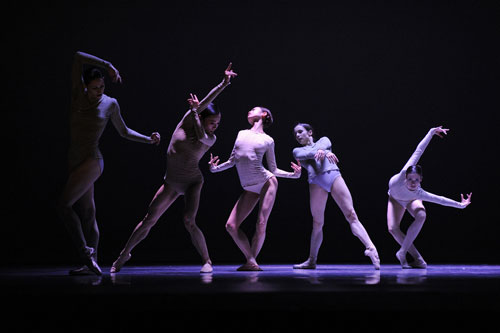 |
Here, too, the verbal language used to explain the conceptual choreography is hermetic and somewhat pompous. "His cerebral form of artistic vision yields technology-integrated dances that explore the human mind as equally as they do the body," the program notes state. It's just too bad that there isn't much newness in either mind or body to explore. As art critic Peter Schjeldahl reminded us in "The Shape of Things," his recent New Yorker review of the New York exhibition "Inventing Abstraction, 1910-1925", Picasso stated that "without reference to things we experience as real, art sacrifices its one indispensable quality: drama."
By pure projection, it is possible to invest Borderlines with some drama, in other words, some meaning, something that might matter. But if post-modern ballet had any intention of expressing the malaise of a deeply depressing, despairing, mechanistic and tortured techno world in purely abstract terms, this artistic borderline has already been reached far more powerfully by McGregor's fore-runner, Bill Forsythe. Forsythe's pieces like Artifact Suite or In the Middle Somewhat Elevated were true artistic edge-work. Of course not every new choreography can be a masterpiece, but by now modern ballet faces a dilemma: How often can you repeat the same pretzeling and noodeling of the body, the off-balance combats between men and women, the athletic horizontal leaps? How often can you crouch in grotesque burlesqeries à la Nederlands Danse Theater, elbows akimbo, duck-feet flexed or turned inward, before everyone yawns? One particular gesture repeated by King and McGregor (as well as other colleagues on the same programs) seems to symbolize the headache of these dilemmas: a dancer, generally a man, grips the top of a woman's head in order to turn her body around. Sorry to say, but not much drama or new enlightenment ensued.
On the whole, the edginess of anti-classical aesthetics more and more resembles a grimace: if a body could grimace, the fashionable post-modern choreographers do just that. They have it down, in unison.
Cover Photo - Herbert Migdoll
|
|